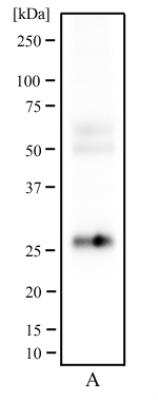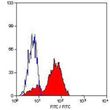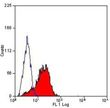TAPA1 (CD81) Mouse Monoclonal Antibody [Clone ID: 1D6]
Frequently bought together (2)
Transient overexpression lysate of CD81 molecule (CD81)
USD 436.00
Other products for "TAPA1"
Specifications
| Product Data | |
| Clone Name | 1D6 |
| Applications | FC, IHC, WB |
| Recommended Dilution | Western Blot: 1 - 2 ug/mL, Immunocytochemistry/ Immunofluorescence: 1:10 - 1:100, Immunoprecipitation: 1:10 - 1:500, Dot Blot, Flow Cytometry: 0.2 - 1 ug per million cells, CyTOF-ready, ELISA, Immunohistochemistry: 1:100, Immunohistochemistry-Paraffin: 1:100 |
| Reactivities | Human, Goat, Primate, Sheep |
| Host | Mouse |
| Isotype | IgG1, kappa |
| Clonality | Monoclonal |
| Immunogen | Aggregated OCI-Ly8 human B cell line |
| Formulation | PBS containing 0.05% BSA, 0.05% Sodium Azide. Store at 4C short term. Aliquot and store at -20C long term. Avoid freeze-thaw cycles. |
| Concentration | lot specific |
| Purification | Protein G purified |
| Conjugation | Unconjugated |
| Storage | Store at -20°C as received. |
| Stability | Stable for 12 months from date of receipt. |
| Gene Name | CD81 molecule |
| Database Link | |
| Background | TAPA1, also known as CD81, is found in the plasma membrane in lymphocytes and is believed to play an important role in the regulation of lymphoma cell growth. This protein is primarily found on B and T cells (lymphocytes) in humans. TAPA1 appears to be involved in a variety of cellular processes including activation, proliferation and differentiation. It is believed to act as a viral receptor for HCV and may play a crucial role in cell signaling from its place embedded in the plasma membrane. Mutations affecting CD81 can cause immunodeficiency- a disease that is characterized by antibody deficiency, hypogammaglobulinemia, recurrent bacterial infections due to a lack of an immune response. |
| Synonyms | CVID6; S5.7; TAPA1; TSPAN28 |
| Note | NB100-65805 is a potent TAPA1/CD81 reagent, it induces homotypic adhesion and has powerful anti-proliferative effects. For Flow Cytometry: Use 10 ul of the suggested working dilution to label 10^6 cells in 100 ul. |
| Reference Data | |
| Protein Families | Druggable Genome, ES Cell Differentiation/IPS, Transmembrane |
| Protein Pathways | B cell receptor signaling pathway |
Documents
| Product Manuals |
| FAQs |
| SDS |
{0} Product Review(s)
0 Product Review(s)
Submit review
Be the first one to submit a review
Product Citations
*Delivery time may vary from web posted schedule. Occasional delays may occur due to unforeseen
complexities in the preparation of your product. International customers may expect an additional 1-2 weeks
in shipping.






























































































































































































































































 Germany
Germany
 Japan
Japan
 United Kingdom
United Kingdom
 China
China





![Flow Cytometry: CD81 Antibody (1D6) TA336485 - A surface stain was performed on Jurkat cells with CD81 Antibody [1D6] TA336485AF488 (blue) and a matched isotype control (orange). Cells were incubated in an antibody dilution of 5 ug/mL for 20 minutes at room temperature. Both antibodies were conjugated to Alexa Fluor 488.](https://cdn.origene.com/assets/images/antibody/primary-antibody/108/ta336485-14-c.jpg?d=110x110)




